Here is a guide for a full understanding of how to use topic clusters examples. Then you’re ready to create your own topic clusters. This post is part of our Articles & Training collection. And, it’s listed in our “How Do You Start A Blog?” article.
Overview of Topic Clusters Examples
The HubSpot topic clusters examples are good for a simple introduction to the level of topic and subtopic. This article remains on the beginner level but gives you a realistic applied approach. We go way past the simple topic and subtopic levels. Also, there is a simple template. And, the illustrations are easy to understand.
What is the Meaning of a Topic Cluster?
Overall, the topic cluster meaning is to have a set of related posts that focus on one main subject. There will be one main post that’s like an overview of several aspects of the subject. Then, there will be other posts that cover each of those aspects. Since they all relate to the same subject, it’s a topic cluster. An example is a main topic of pizza recipes. The subtopic posts would be recipes like pepperoni pizza, sausage, cheese, & supreme pizzas.
A main topic is sometimes referred as a pillar topic. That’s usually at the top of your cluster. Then, it branches out to its related subtopics. Topic Clusters can be small or large.
A small cluster example is to have 1 post as the main topic. Then there are 3 related posts covering subtopics of that main one.
A large cluster example is to have 1 post on the very top as a pillar topic. Then, there could be 5 posts covering several main topics based on that pillar topic. After that, each of those main topics could have 3 to 5 subtopics of each aspect of their main topic.
How Do I Create a Topic Cluster?
To create a topic cluster, just document your thoughts for content, using a simple template. We have a topic cluster template near the end of this article. Use it! If you want to make a large topic cluster, use the template for each main topic. Do this even if you only have partial ideas about your subject for topics.
Choose one main topic and use the template. Use the template once for each main topic. For large clusters, use several templates. And, it will be one for each main topic. Also, some of your subtopics will develop into their own sub-subtopics. Create a massive set of partially defined pillar or main topics, their subtopics, and their “sub-subtopics”.
Back at the beginning level, the basic idea is to show a very simple topic cluster. Then, us using different terms that have similar meanings, e.g., Main Topic and Pillar Topic are sometimes the same. And yes, a Pillar Topic can start with just 3 subtopics. After all, a Pillar Topic is just the starting main topic.
What is a Pillar Topic?
Consider a pillar topic as the highest level of a main topic. That’s all it is. Sometimes Pillar Topic and Main Topic reference the same thing. Regardless, the highest point of the “Pillar” is the top level of any topic. So, the pillar topic can have several subtopics. And, some of those subtopics might be main topics themselves. And that’s because they might have subtopics underneath them. While something might be a subtopic to a Pillar topic, it might also be a Main topic if it has some supporting subtopics underneath it. What does that mean?
For example, let’s say there’s a pillar topic. And that it has 5 topics underneath it. And then 2 of those have subtopics underneath them. So, in this example, the main topic is the pillar topic when you’re looking at any of its 5 topics underneath it. At that moment, those 5 topics are subtopics.
Now, with that same thought, look at the 2 of the 5 topics that also have their own subtopics. Those 2 are main topics only while you’re referencing them along with their subtopics. Keep reading and you’ll see the topic clusters examples showing this.
How to Create a Topic Cluster
All site owners should understand how to create a topic cluster. Create a topic cluster easily. Start with a primary high-level topical subject. Then, create some subtopics.
And some of those subtopics provide a deeper dive into more details. These lower levels of the subject’s subtopics become their own main topics. That happens when you add articles covering their different detailed aspects.
Next, satisfy SEO purposes and expand a topic cluster to cover the subject completely. Create the topics and subtopics commonly related to it. Keep reading to understand how to include topic clusters SEO in your plan.
Planning a Topic Cluster SEO
Activate a topic cluster SEO strategy by filling out a Topic Cluster Plan Form. For this, see our topic cluster example plan form. It’s a starter for your personal usage near the end of this article. Plan your topics and subtopics on it. Use this plan to achieve higher search engine ranking results. Initially, focus on topics with high volume and low SEO competition. Some tools offer this detailed info. WriterZen and UberSuggest have keywords clustering analysis. However, WriterZen’s data analysis is actively current every day.
Topic Clusters Examples
Now let’s see a good number of topic clusters examples. These cover a variety of simple topic clusters to complex topic clusters. Also, these topic clusters illustrate both in a general nature and then with specific topics shown as blog examples of clustering.
Simple Topic Clusters Examples
Here are 2 Simple Topic Clusters Examples. Start with a Main Topic or a Pillar Topic. The Pillar Topic is similar, except it has a planned future intention of much further expansion of multiple main topics and their subtopics. The developer’s intention is sitewide for multiple pillar topics that involve multiple topic clusters in each. So, although more extensive, it all starts with a small set of topics. And those topic posts will grow into any level within the topic cluster.
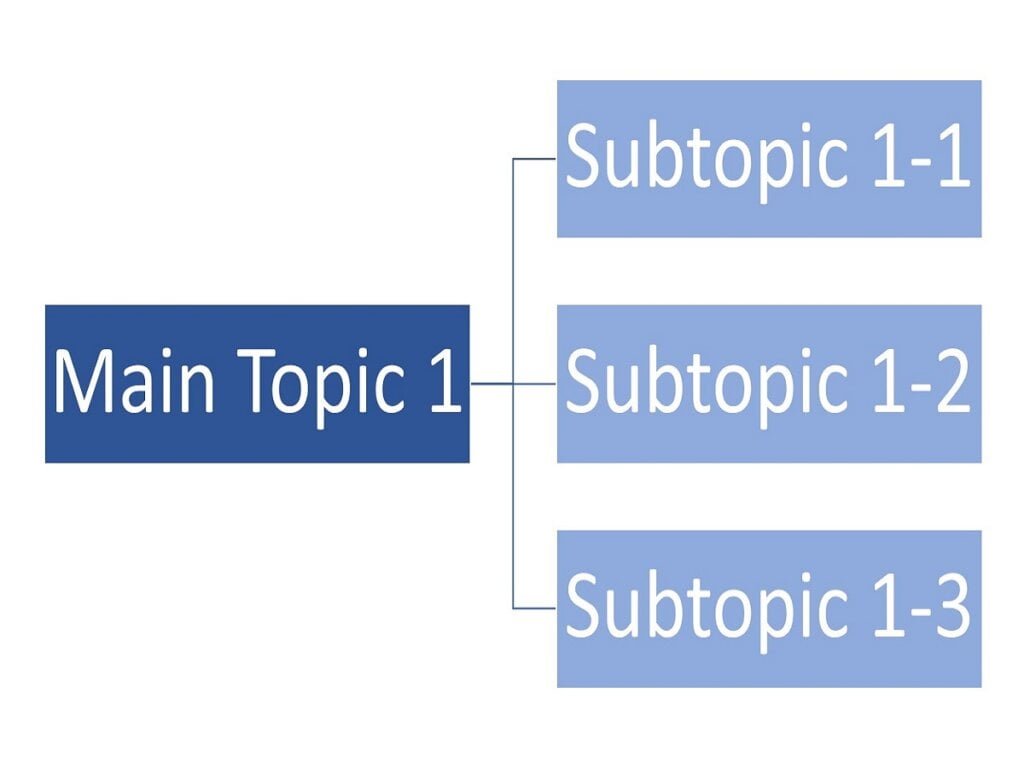
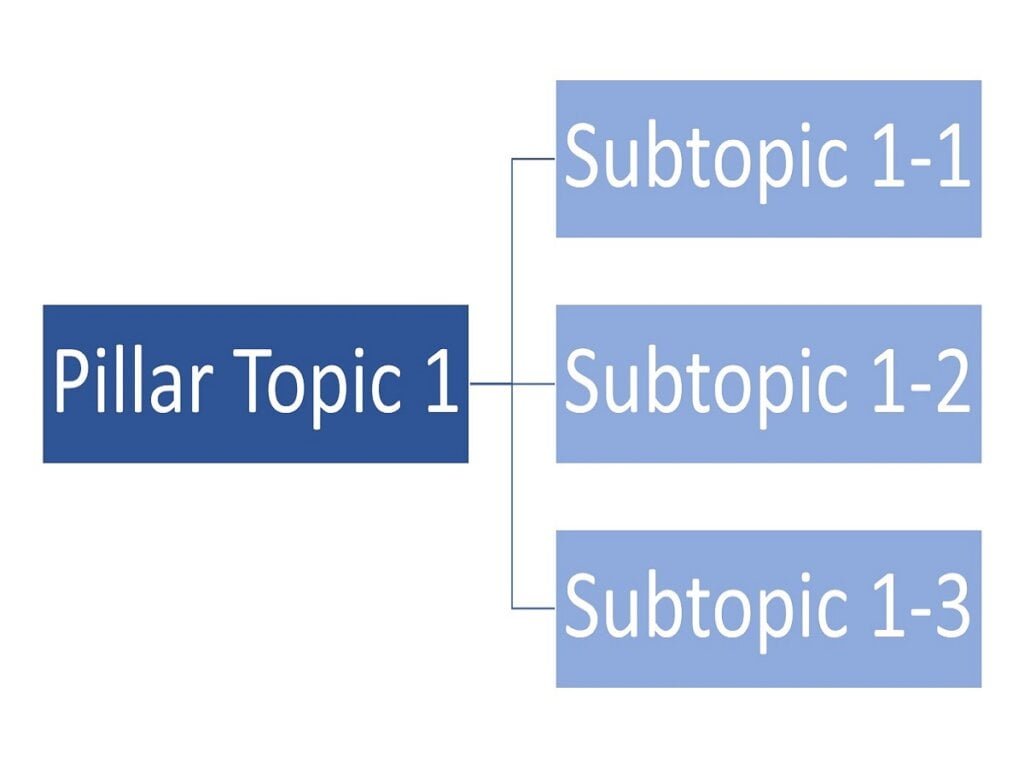
Topic Clusters Examples using Pillar Topic, Main Topic, and Sub Topics
Now we’re going to see a more expanded set of topic clusters examples. This example goes 3 layers deep. This is common when covering a good amount of a subject. Soon, see how a previous subtopic has its own subtopics (like a sub-subtopic). At that point, the higher level subtopic now wears 2 hats. In this example, it’s both a main topic combined also as a subtopic to the higher main or pillar topic.
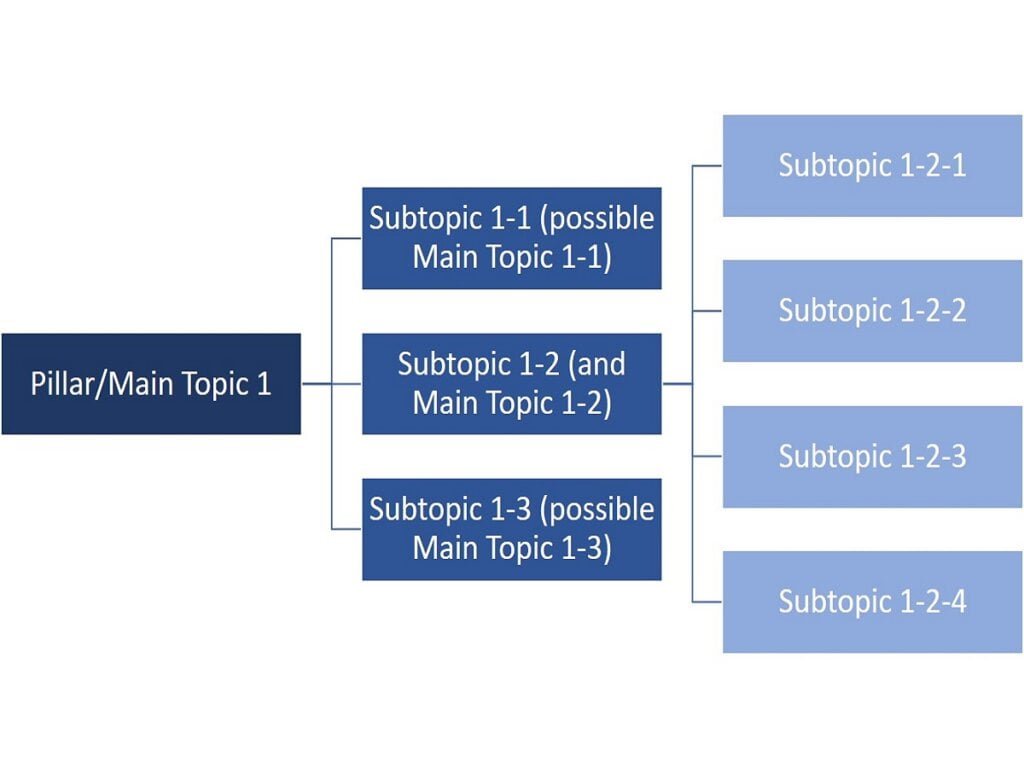
Specific Topic Clusters Examples: Cooking on a Charcoal Grill
Here is the first of specific topic clusters examples. It’s a food blogging topic. The pillar topic or main topic is about cooking on a charcoal grill. Pillar or main topic illustrates a lot of subtopics that fall very well under it. Subtopics cover charcoal grill types, lighting, accessories, cooking with indirect heat, charcoal types, safety tips, and recipes.
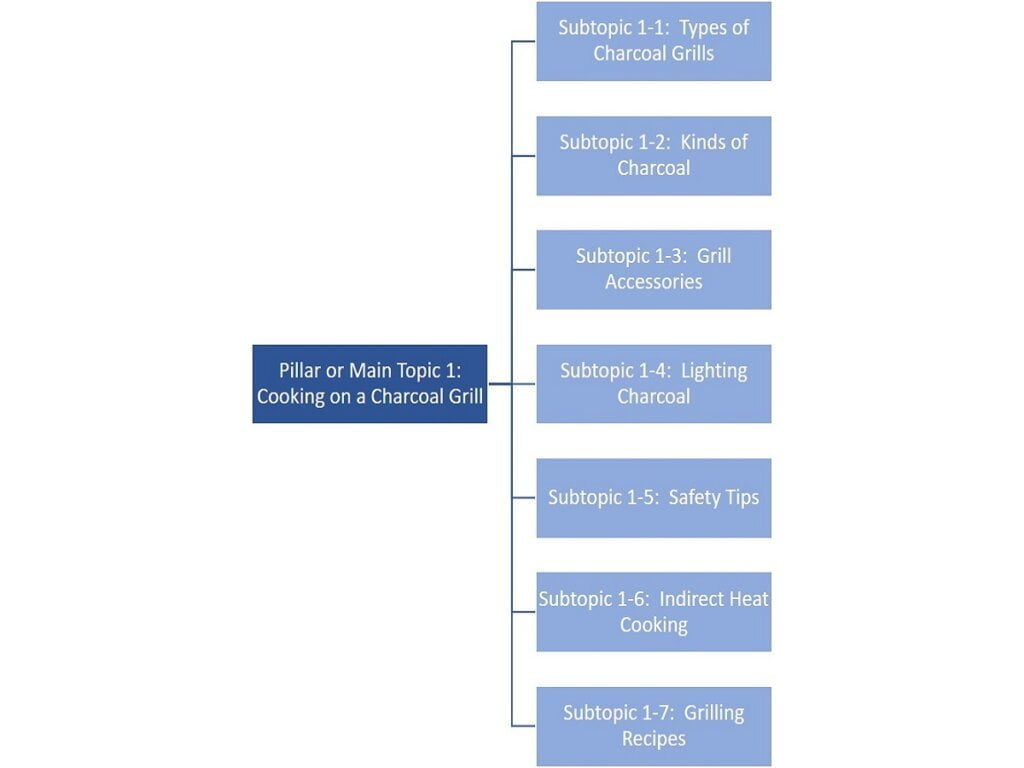
Pillar Page Topic Cluster Specific Extended Examples
Here is a pillar page topic clusters example specifically extending the subject of “Outdoor Cooking”. As a pillar topic, it (Outdoor Cooking) could have its own subtopics. And those subtopics could also become their own topics. Subtopic examples are “cooking on a charcoal grill”, “types of grills and smokers”, “determining a grill location”, “canopies for grills”, “preparing the backyard for a barbecue party”, and so on.
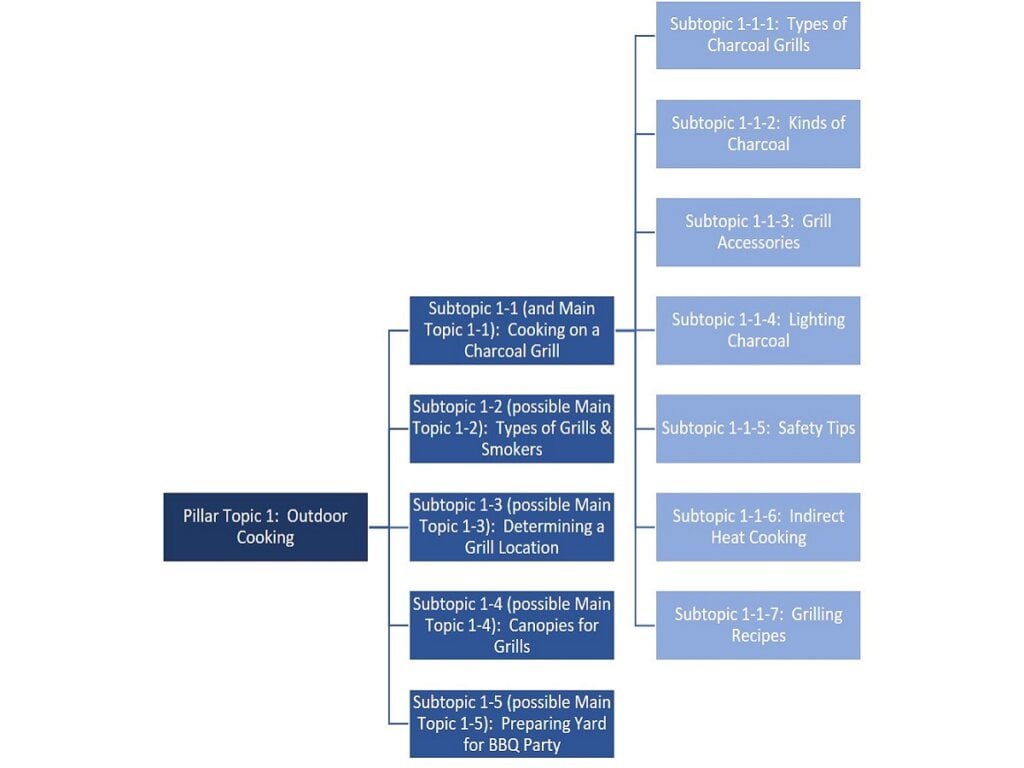
Here is an idea of the same such pillar topics examples, but some subtopics become extended. Therefore, they are main topics with their own subtopics. So, you now have a mix of main topics and subtopics. You might start with a pillar topic such as “outdoor cooking” and then you’ll write out some subtopics of the various aspects. Over time, one of those subtopics, e.g., types of outdoor grills, might develop into becoming its own main topic. Then, subtopics are gas grills, charcoal grills, electric grills, pellet grills, duo-energy grills, etc.
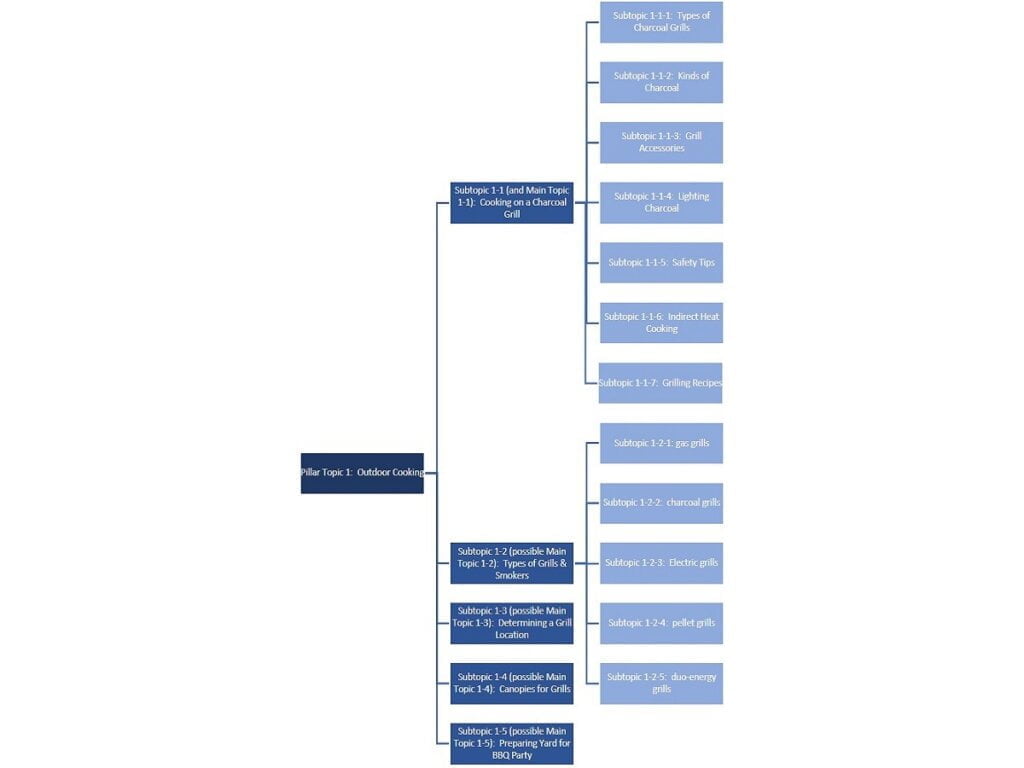
With that in mind, you don’t have to have all the pillar topics, main topics, subtopics, of all aspects and layers created. Focus on one of the primary topics. Then, focus on associated subtopics. Keep in mind one of those subtopics down the road might later become a large main topic of its own. You don’t have to make it one right now. It’s too cumbersome. You’re not writing or developing for the entire site overall. You’re staying with one main topic and only its immediately associated subtopics. That leads us into our next topic, strategy.
Topic Clusters Examples of Content Strategy
Now we cover topic cluster content strategy examples. During planning and operational content development, you might find you need to change a post. You decide to rewrite it to cover a topic more broadly or in more detail. So, you change your topic cluster content strategy. Let’s look at an example of a strategy issue and how it’s corrected.
Resolving Duplicate or Related Content in Topic Cluster Strategy
In the previous hierarchy example shown, a subtopic of “types of grills” eventually became a topic of its own. It requires several subtopics to cover each type of grill. We have an issue because we already covered the “Types of Charcoal Grills”. The subtopics are already on another topic named “Cooking on a Charcoal Grill”. So you don’t want 2 strongly related articles using the topics of “Types of Grills & Smokers” and “Cooking on a Charcoal Grill”. Here’s an example of a topic cluster content strategy issue discovered.
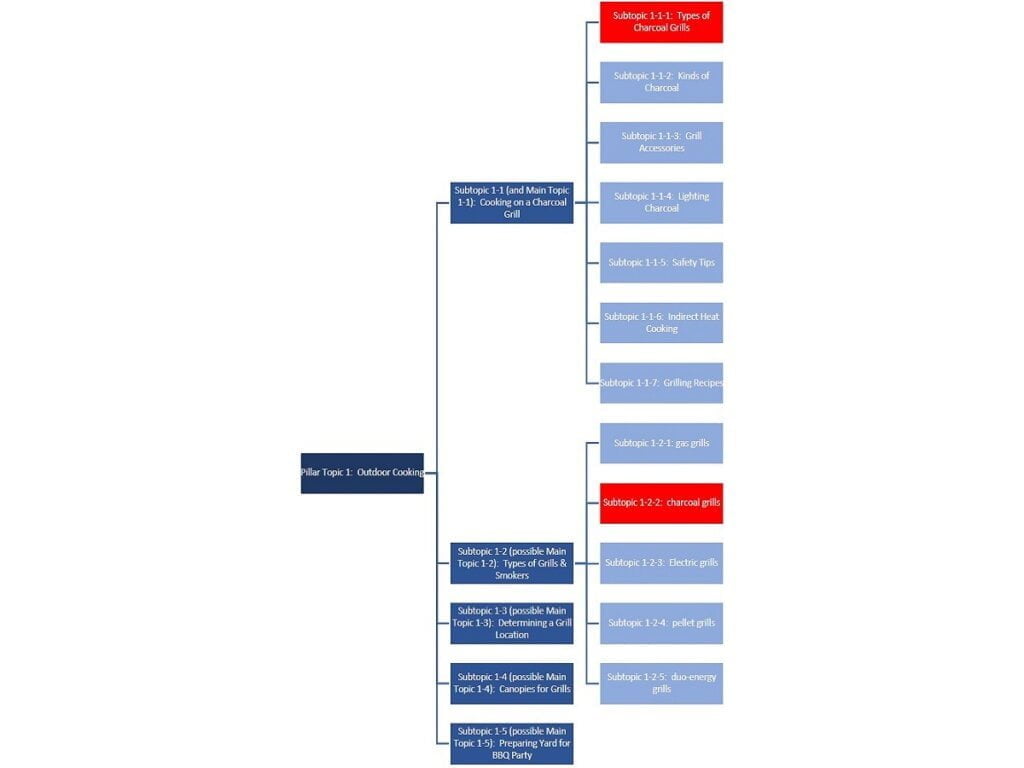
Cluster Content Strategy Step 1. Rewrite an article to better cluster fit
So, sometimes, rewrite an article to better fit under a different topic. And when you do that, also write a new one for the newer topic. In this example, you rewrite the article “Types of Charcoal Grills” to be “Cooking with Different Charcoal Grills” on each of them, showing their pros and cons. Then, after that rewrite, you are ready to write the new article as this is a 2-step strategy solution.
Cluster Content Strategy Step 2. Create a new article for new topic aspect
Now create a new article that focuses overall on “charcoal grills” as a topic that briefly covers “cooking aspects”. You also include a link to the rewritten post “Cooking with Different Charcoal Grills”. The new article of types of charcoal grills covers aspects such as durability, warranties, ventilation differences, ease-of use, and so on. Problem solved. Here’s that topic cluster content strategy example solution.
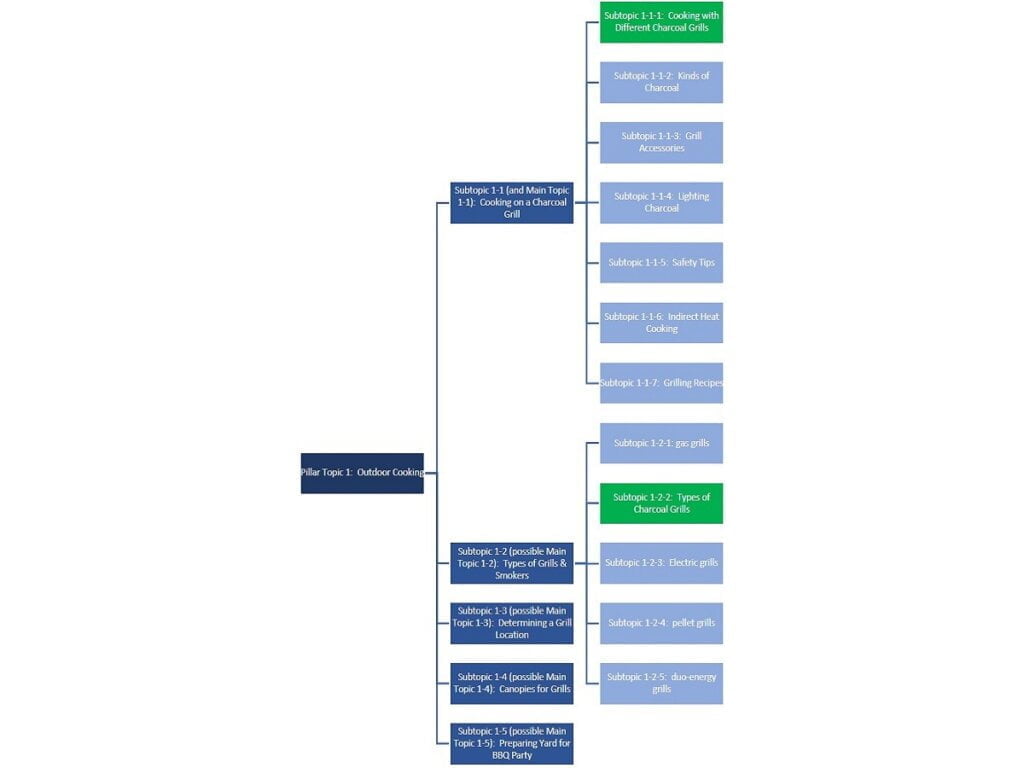
Order of Writing Main Topic and Subtopics
What is the order of writing the main topic and subtopics? This is like which came first, the chicken (topic) or the egg (subtopic). Some professionals advise writing a pillar topic along with all or most subtopics, and then to publish them all at once. Create the chicken and the eggs, and published the family all at once. Without a modest-sized writing staff, that is incredibly impractical. It’s also bad for SEO if you go a long time without updates to your site.
Fortunately, much of the Internet content revolves around individual items being published one at a time. To create a pillar topic, start by publishing subtopic posts and linking them together once you have enough. Or, the reverse, you can write the pillar topic and then add links to the subtopics as you write them.
It’s good for SEO, because you reviewed the overall topic and its subtopics relationships each time you published an update. Every time you add new links between subtopic and topic, you’re increasing your expertise in a subject.
Two Practical Orders of Writing Approaches
A topic cluster has 2 practical orders for writing approaches. The first one is the preferred and the second one is an alternate method that some may choose to use. Also, you may find certain times where you are better suited to follow the secondary approach.
Preferred Topic Clusters Examples Plan Starting with Subtopics
The most common and practical approach for topic clusters examples planning is to start with subtopics development. Create and publish about 3 to 5 subtopics of your potential main (or pillar) topic. You then write and publish the main or pillar topic around those 3 to 5 subtopics. You then have some content to link up to in your main or pillar topic. Continue your topic cluster development.
Alternate Topic Clusters Examples Plan Starting with Main Topic
In this example, you can start your topic clusters examples plan by writing its main or pillar topic. As you may not have any subtopics yet to link to, you will usually have to link outward more often to external sites for related content. After that’s published, you can then gradually create and publish your own related subtopic posts for various sections on the main topic. From your main or pillar topic, you also then add a line or two with a link to your newly published subtopic post.
This alternate method takes longer overall. External link research takes more time than using internal links you already have.. Also, you have nothing to feed content from when writing it. In the other planned method, you could write each main topic section as you feed off of a pre-existing subtopic post you’ve already done.
Future Development of Topic Cluster
Periodically publish a new subtopic. Then, add a new section to the pillar/main topic. Exchange links between the main topic post and the new subtopic post.
It’s at this good stage of site development to update your pillar/main topic when you’re publishing a new subtopic. You improved your topic cluster. And, your site has a new post.
When Subtopics Evolve Into a New Main Topic
Eventually, some of your subtopics in a pre-existing topic cluster will develop. A subtopic will branch out into becoming its own main topic. Here, you write new subtopics based on this subtopic. And, you add links exchanged between the new post and the pre-existing one. Over time, you’ll need to have around 3 to 5 new subtopic posts to validate the new main topic.
Let’s look at an example in the food niche. You wrote some subtopics under the Pillar topic of “Breakfast”. You wrote many recipes and articles about breakfast. Eventually, you find you have a large amount of posts about eggs. Make a new main topic called “Breakfast With Eggs” and add links to your subtopics “Scrambled Eggs” and “Western Omelet”. You can also add links about the history of cooking eggs and using eggs in French toast and waffles.
So, in that example, “Breakfast” is a topic cluster and “Breakfast With Eggs” is another one. In this example, they both share some of the subtopic posts links.
When One Subtopic Becomes a New Main Topic
Sometimes, as you’re writing a subtopic, you discover there are a lot of further aspects you could write about on it. An example might be when you’re writing on the subtopic of “Breakfast Beverages” under the pillar topic of “Breakfast”.

During the writing of content and process, you cover milk, juices, coffee, and others. Writing about coffee reveals your knowledge of espresso, beans, grinding, strengths, and additives.
In this example, you can take 2 approaches. You can add a bulleted list of those aspects in the coffee section and then insert links as you write about each one. Or, you can eventually write a new main topic on “All About Coffee” and insert its single link into your coffee section. Then, you continue to develop that topic article of “All About Coffee”, and gradually add in links to those many subtopics.
Topic Clusters Examples of Topic and Subtopic Terminology
Content planning articles often cause confusion by loosely using the terms “Pillar Topic”, “Topic”, “Main Topic”, and “Subtopic”. In an author’s mind, they might write for someone who has a beginner’s level of understanding. People often forget to tell readers when they’re talking about a “topic” that could mean the main topic or one of its subtopics with more subtopics. It’s complicated for beginners.
Nearly everyone is avoiding the use of a term sub-subtopic. So, without a new term for that, we remain somewhat limited in teaching intermediate and advanced topic clusters structure. So, the terms remain interchangeably used and readers remain making their own interpretations.
Quantitative Approach to Organizing Topics Terms
A truly organized approach would be to refer to all topic levels in an outline form. One example could be as follows. The pillar topic could be T1. The first subtopic level could be T1-1. And, the first sub-subtopic could be T-1-1. Topic T1-1-1 (as the sub-subtopic of the T1 pillar topic and also doubles as the subtopic of T1-1). In this way, when we refer to Topic T1-1, we’ll know it’s the subtopic of the pillar topic and that it’s also the topic of the subtopics level of TopicT1-1-1.
Alternate display options could also be T1, T1.1, T1.1.1, for example.
Qualitative Approach to Organizing Topics Terms
However, we reject quantitative approaches, such as using T1 or T1-1. That’s because they’re too technical. People like a more qualitative approach that uses terminology. Unfortunately, content cluster terms remain an ongoing issue in this industry’s education. Fortunately, the overall topical structure of publishing a subject uses a sound method. We write the topics in a hierarchy of related content.
Terminology of Topic Clusters Examples
Here are some FAQs related to the subject of Topic Clustering. The emphasis is regarding writing articles or material for online or offline readership.
Topic Clusters Examples Terminology: What is a Topic?
When content writing of posts and pages, a “topic” is a general term for the broad coverage of the subject that is the currently emphasized. We do not restrict it to the highest level of a topic’s subject. Sometimes when using the term “topic”, it might reference the post that is currently acting as a subtopic of a larger main topic. When we intend to focus on the subtopic’s subject, we still often use the term “topic”.
Topic Clusters Examples Terminology: What is a Subtopic?
A Subtopic is a general term for a more detailed coverage of part of a broader subject. It’s commonly used when referencing it as part of a higher level topic. We restrict it to one level under a topic it is expanding on.
It is worthy to note a Subtopic’s subject can also have its own Subtopics under it. So, if they offer separate, more detailed coverage emphasis of some of its portions. In such cases, the higher level Subtopic doubles as a “Subtopic” to its Topic and also acts as a “Topic” over its added Subtopics, if they exist. When referring to the content relative to it being under a higher topic, it’s referred as a “Subtopic”. When referring to separate writings further expanding on some of its sections, we can then refer appropriately to it as a “Topic”.
Topic Clusters Examples Terminology: What is a Pillar Topic?
A Pillar Topic is the highest level of a Topic on a defined entity of an entire subject source, such as a website. We consider a Pillar Topic the most broad coverage of a subject. Also, a Pillar Topic often offers a general starting point of knowledge and information about any topic.
Pillar Topics don’t provide active, functional, detailed knowledge. Readers get a good understanding of the primary topic. The pillar topic post leads directly to detailed active information through its subtopics.
Subtopics are the active, detailed, expanded material of the Pillar Topic. Some subtopics develop into having their own subtopics to further add detailed knowledge. These are Sub-subtopics.
Here is an example of a Pillar Topic posting as “Homemade Pizzas in Oven” on a food blog. While the Pillar Topic covers pizza recipes, it also covers everything involved in making those recipes. Other subtopics include equipment, ingredients, planning, storing, and reheating pizza.
Topic Clusters Examples Terminology: What is a Main Topic?
A Main Topic is often used interchangeably as a Pillar Topic. However, if that Main Topic’s subject matter is at such a high level that it won’t have anything written higher, it’s primarily referred as a Pillar Topic. However, in that scenario, it’s also understood that there will be many expanded materials covering it much further in detail. So, a Main Topic is anything noted as a subject matter that will clearly have other Subtopics covering it in more detail and further expanded.
Topic Clusters Examples Terminology: Complex Topic Cluster
A Complex Topic Cluster is when you have more than one Topic Cluster and there is some overlapping subject among the clusters.
SEO Topic Clustering Strategy
An SEO Topic Clustering Strategy is when you use a set of methods to create, maintain or improve search engine results of your content. The strategy is to reposition your content’s optimization results for higher positioning.
Using a Topic Cluster Plan is important for defining a well-organized subject’s coverage and topical structure. An SEO Topic Clustering Strategy ensures a full coverage of a topic is in the contents’ development. Using a Topic Discovery Tool such as found in WriterZen is one SEO planning strategy. Another strategy is to use a template for a Topic Cluster Plan, such as the one included in this article.
Topic Clusters Examples of SEO Strategies
Knowledge of Topic Clusters Examples of SEO strategies is important. Here are some examples.
- Include a link in each subtopic’s first paragraph leading upward to its main topic.
- Ensure you use strongly related links between each subtopic and their topics’ articles.
- Monitor keyword ranking to know when to update your posts. When it’s time to update, review current, actively responsive keywords on the topic. Then, improve your post by rewriting the content to match the newer details.
What is Keyword Clustering SEO?
Keyword Clustering SEO is when you have a lot of keywords all related to a pillar or main topic. Keyword clustering SEO tools use a list of keywords and organizes them into related subtopics The service WriterZen uses such a clustering tool as a feature.
The benefit of having such a keyword cluster tool is is can help you define subtopics belong to a pillar or main topic you’re considering writing about. Also, it can help you determine which keywords are potentially better suited for each subtopic.
Topic Cluster Template Plan Form
Here is a Topic Cluster Template Plan Form as an example. The instructions provide guidance.
Instructions for General Use of the Topic Cluster Template Plan
Use this template as a draft for a starting topic cluster plan. You don’t need research initially. That comes later. Just draft out your initial ideas of titles, topics, and subtopics.
For complex topic clusters, use several forms. Use one form for each main topic. Subtopics sometimes fall into a different category. Categories refer to the site’s topography.
Topic Cluster Plan Form
Date Started: ______________
Main Topic/Pillar Title: __________________________________________________________________
Main Topic/Pillar Category: ___________________________________________
| Nbr | Sub Topic Title | Sub Topic Category |
|---|---|---|
| 1 | ||
| 2 | ||
| 3 | ||
| 4 | ||
| 5 | ||
| 6 | ||
| 7 | ||
| 8 | ||
| 9 | ||
| 10 | ||
| 11 | ||
| 12 | ||
| 13 | ||
| 14 | ||
| 15 | ||
| 16 | ||
| 17 | ||
| 18 | ||
| 19 | ||
| 20 |
Related to Managing SEO
Below are our related articles. And, here’s a good external article “6 Topic Cluster Examples To Get Your Inspired” by Suman Samai on Scalenut.com. Also, read the related post “How To Narrow Down Your Food Niche Ideas“.
Conclusion
You now have seen Topic Clusters Examples and a lot of terminology used. And, you understand what a Topic Cluster is. Also, you now have an easy Topic Cluster Plan template to use. And, you’ve seen how to update changed main topics and subtopics over time. You also read examples of how subtopics become their own main topic. And, the terminology used for topic clusters has now been easily explained. Send me your comments as this topic is always changing.
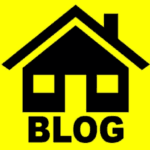

1 comment
Clifton
Much better post on topic clusters than I’ve ever seen. The others didn’t go deeper than 1 basic level and some of their others explanations re-used the term ‘subtopic’ when I thought it was a sub-subtopic. You explained it so much better and in detail on when that term is both a subtopic and how it could also be a sub-subtopic for expanding an extra layer. It’s all related to the layer you’re focused on, that defines what you name it. You worded those relationships extremely well.